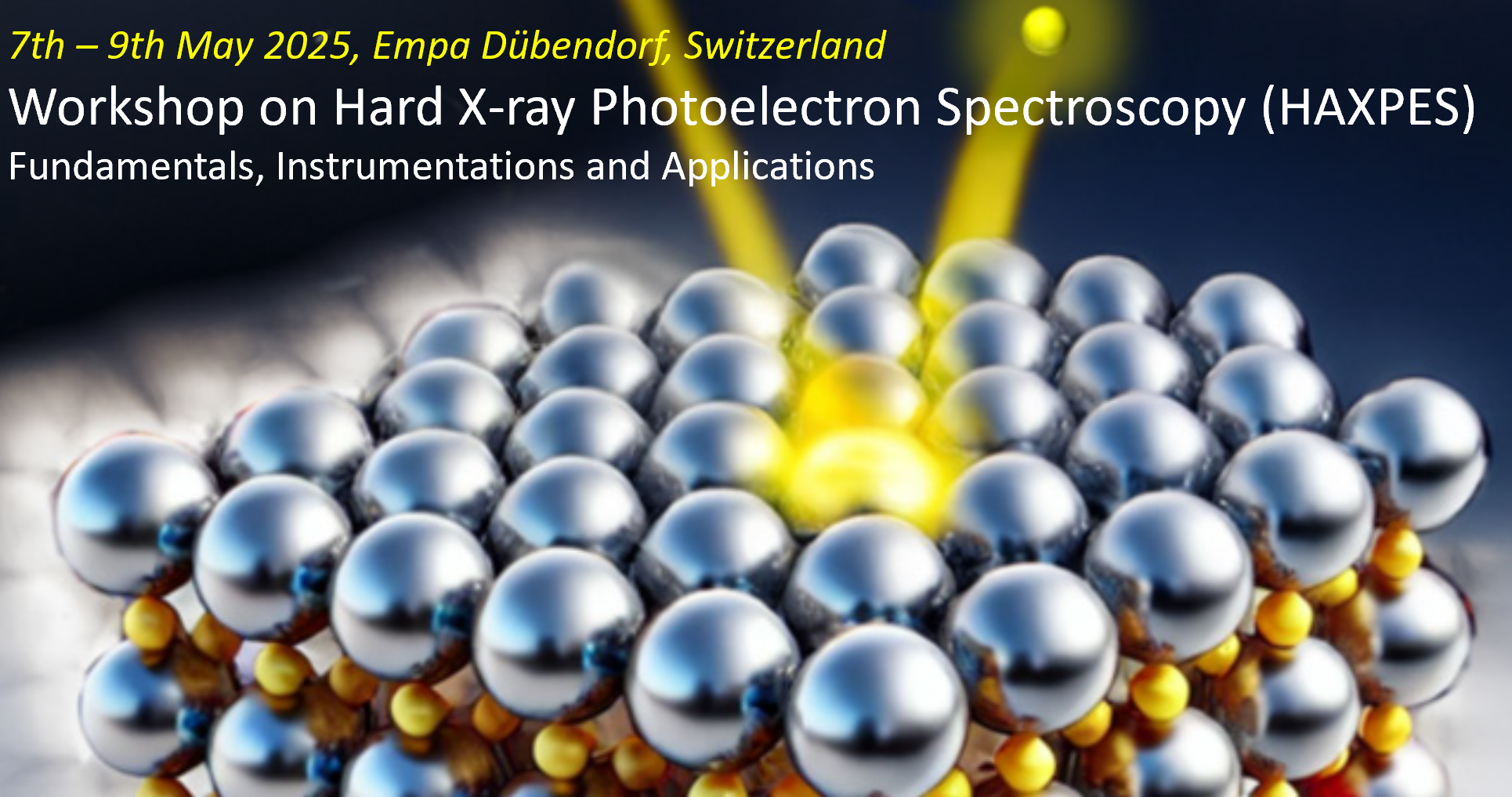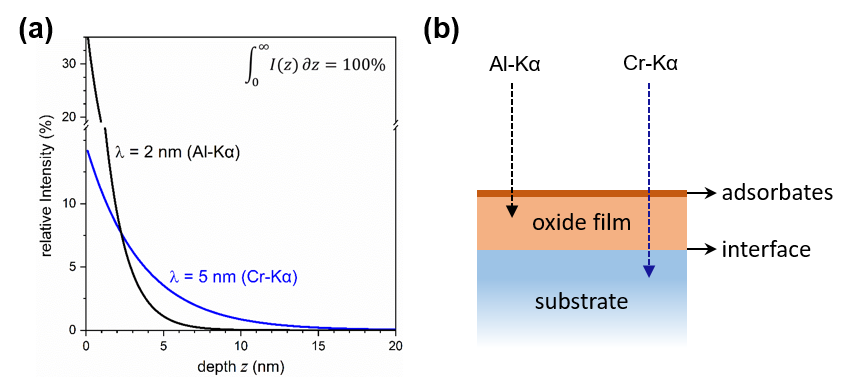Hard X-ray Photoelectron Spectroscopy (HAXPES)
Our PHI QUANTES XPS/HAXPES is the only laboratory-based Hard X-ray Photoelectron Spectrometer in Switzerland (with only few similar systems installed worldwide). The instrument combines a high-energy monochromatic Cr-Kα X-ray source (hν = 5.41 KeV) with a conventional low-energy monochromatic Al-Kα X-ray source (hν = 1.48 KeV) for state-of-the-art investigations of the chemistry and electronic structure of functional thin films, mutlilayers and their buried interfaces. For more details, have a look here. The XPS/HAXPES instrument is directly coupled to versatile in-situ experimental capabilities (all having a 3" wafer compatibility), including thin-film growth, post-processing and (electro)chemical and gaseous surface treatments.

NEWS: Upcoming HAXPES workshop
It is a pleasure to invite you to the HAXPES workshop on "Fundamentals, Instrumentations and Applications" which will be held at Empa on May 7th -9th , 2025.
The workshop offers scientists, students, and researchers an opportunity to learn about the latest Hard X-ray photoemission spectroscopy developments worldwide, as carried out in the laboratory and at synchrotron facilities. Renowned national and international experts in the HAXPES field will contribute with 10 keynote and many invited lectures. It is a unique opportunity for anyone working in or interested to join the field.
The detailed technical program is now available for download below. Note only a few registrations are still available. Register soon!
The full technical program will be available soon. We are looking forward to welcoming you!
Warm regards,
Claudia Cancellieri & Lars Jeurgens
INSTRUMENTAL CAPABILITIES
The hard Cr-Kα X-ray source allows to obtain elemental and chemical information from roughly three times larger probing depths (i.e. 3λ·sin(θ) = 20 - 25 nm at θ = 90°) as compared to the conventional soft Al-Kα X-ray source (i.e. 3λ·sin(θ) = 6 - 8 nm at θ = 90°); see figure below. This opens unique opportunities for probing "true" thin film properties (probing the volume of the film instead of its surface) as well as deeply buried interfaces (i.e. up to 10 - 20 nm), while at the same time minimizing unwanted signal contributions from surface contamination and ion-induced sputter damage.

Furthermore, the use of hard X-rays in HAXPES provides access to a wealth of deep core-level photoelectron lines and their associated core- core Auger transitions, which are not available by soft X-rays. This allows advanced chemical-state studies on the basis of the so-called Auger parameter, which is highly sensitive to changes in the local chemical environment of the constituents as function of e.g. the growth, processing and/or service conditions.
The PHI Quantes scanning microprobe is equipped for fully automated analysis of multiple samples placed on the default 7x7 cm2 stage, as well as on a 3" wafer size platen (custom-designed for in-situ studies and worldwide only available at Empa). The monochromatized soft and hard X-ray beams can be focussed to achieve a lateral resolution down to 10 μm and also scanned across the sample surface to define analysis points, areas, lines and maps. Surface charging during analysis of electrically insulating samples can be compensated by simultaneous electron and ion neutralization. Besides the interconnected glovebox for (electro)chemical surface treatments (see below), a much smaller transportable glove box can be attached to the entry lock for mounting ex-situ samples under an inert gas (without air exposure).
ANALYTICAL AND EXPERIMENTAL CAPABILITIES
Our dual-beam XPS/HAXPES instrument offers the following analytical advantages for tackling your research (for details, see here):
-
A much-increased attenuation length of detected photoelectrons from shallow core levels, thus allowing non-destructive analysis of the chemistry and electronic structure of thin films and their buried interfaces up to depths of about 10 - 20 nm.
-
Access to deep core-level photoelectron lines and deep-core-level Auger transitions, which are not accessible by conventional lab-based XPS systems, allowing cutting-edge chemical-state studies of functional thin films, catalysts and other types of functional nanomaterials.
-
Capability to separate commonly-overlapping photoelectron and Auger lines by employing much higher incident photon energies, thereby facilitating chemical-state and quantitative XPS analysis of complex multi-element compounds.
-
Extended capabilities for non-destructive quantitative XPS analysis of e.g. the composition, thickness, chemical state of thin films, catalysts and other nanomaterial systems.
Our dual-beam XPS/HAXPES instrument is directly coupled to versatile in-situ experimental and analytical capabilities for sample diameters up to 3" in diameter (and a maximum height of about 10 mm):
-
In-situ physical vapor deposition (PVD) of metals, oxides and nitrides by magnetron sputtering with the option to monitor the stress by wafer-curvature during film growth (k-space kSA MOS), as well as the thickness and optical properties by spectroscopic ellipsometry (Woollam, In-situ iSE)
-
In-situ thin-film post-processing (e.g. in-situ thermal annealing, oxidation, reduction)
-
In-situ (electro-)chemical surface treatments (e.g. electrochemical functionalizing, etching, anodizing) in the interconnected Ar-glovebox.
-
In-situ heating up to 1 bar in mixed gaseous atmospheres (e.g. O2, H2, N2, H2O) without exposure to air, using a special-designed microfurnace in the interconnected Ar-glovebox (Irelec Microfurnace)
TYPICAL HAXPES SERVICES OFFERED TO INDUSTRY
-
Quantification of the composition, chemical state and thickness of thin films, multilayers and functional surface coatings with a lateral resolution down to 10 micrometer (probing depth up to 20 - 30 nm).
-
Investigations of the chemistry and electronic structure at buried interfaces, nondestructively up to a probing depth of about 20 - 30 nm, as well as destructively by sputtering up to probing depth in the submicrometer range.
-
Investigation of the chemical bonding state of secondary nano-phase(s) dispersed in a solid matrix, as well as of core-shell nanostructures.
-
Employing different photon energies to resolve commonly overlapping photoelectron and Auger lines for chemical-state and quantitative XPS analysis of complex multi-element compounds, such as catalysts.
-
Charaterization of the passive oxide on e.g. steel surfaces before and after specific gaseous (e.g. nitriding) and (electro-)chemical treatments (e.g. conversion coatings), if needed without air-exposure between intermediate processing steps.
EMPA PUBLICATIONS USING LAB-BASED XPS/HAXPES
2025
-
C. Cancellieri, G. Lorenzin, M. Lyanage, V. Turlo, J.F. Watts, L.P.H. Jeurgens, Chemical and Electronic Structure of Buried W/Cu, W/Cr, and W/Mo Interfaces by In Situ XPS/HAXPES Auger Parameter Analysis, Surface & Interface Anaylsis (2025) early view [DOI: 10.1002/sia.7391].
2024
- F. Longo, P.J. Lloreda-Jurado, J. Gil-Rostra, A.R. Gonzalez-Elipe, F. Yubero, S.L.J. Thomä, A. Neels, A. Borgschulte, Hard X-ray Photoelectron Spectroscopy Probing Fe Segregation during the Oxygen Evolution Reaction, ACS Applied Materials & Interfaces 16 (2024) 9516–59527 [DOI: 10.1021/acsami.4c11902].
- L.P.H. Jeurgens, C. Cancellieri, A. Borgschulte, J.F. Watts, Editorial: Advancements and challenges of HAXPES for materials sciences and technologies, Surface and Interface Analysis 56 (2024) 397-398 [DOI: 10.1002/sia.7318].
- R. Cestaro, P. Schmutz, Chemical Stability and Reactivity of Electrochemically Grown Manganese Oxide Films, Electrochimica Acta (2024) 144097 [DOI: 10.1016/j.elecacta.2024.144097].
- C. Cancellieri, S. Gramatte, O. Politano, L. Lapeyre, F. Klimashin, K. Mackosz, I. Utke, Z. Novotny, A. M. Müller, C. Vockenhuber, V. Turlo, L. P. H. Jeurgens, Effect of Hydrogen on the Chemical State, Stoichiometry and Density of Amorphous Al2O3 Films Grown by Thermal Atomic Layer Deposition, Surface & Interface Analysis (2024) [DOI: 10.1002/sia.7282].
- F. Longo, Marin Nikolic, Andreas Borgschulte, Deep core level hard X-ray photoelectron spectroscopy for catalyst characterization, Surface & Interface Analysis (2023) [DOI: 10.1002/sia.7267].
- F. Longo, E. Billeter, S. Kazaz, A. Cesarini, M. Nikolic, A. Chacko, P. Schmutz, Z. Novotny, A. Borgschulte, Hard X-ray photoelectron spectroscopy reveals self-organized structures of electrocatalytic nickel oxy-hydroxides, Surface Science 739 (2024) 122397 [DOI: 10.1016/j.susc.2023.122397].
2023
- H. Zhang, G. Paggiaro, F. Okur, J. Huwiler, C. Cancellieri, L.P.H. Jeurgens, D. Chernyshov, W. van Beek, M. Kovalenko, K. Kravchyk, On high-temperature thermal cleaning of LLZO solid-state electrolytes, ACS Energy Materials 6 (2023) 6972–6980 [DOI: 10.1021/acsaem.3c00459].
- D.N. Dirin, A. Vivani, M. Zacharias, T. Sekh, I. Cherniukh, S. Yakunin, F. Bertolotti, M. Aebli, R.D. Schaller, A. Wieczorek, S. Siol, C. Cancellieri, L.P.H. Jeurgens, N. Masciocchi, A. Guagliardi, L. Pedesseau, J. Even, M.V. Kovalenko, M.I. Bodnarchuk, Intrinsic formamidinium tin iodide nanocrystals by suppressing the Sn(IV) impurities, Nano Letters 23 (2023) 1914–1923 [DOI: 10.1021/acs.nanolett.2c04927].
- H. Zhang, F. Okur, C. Cancellieri, L.P.H. Jeurgens, P. Annapaola, D. T. Karabay , M. Nesvadba , S. Hwang , A. Neels, M.V. Kovalenko, K.V. Kravchyk, Bilayer Dense‐Porous Li7La3Zr2O12 Membranes for High‐Performance Li‐Garnet Solid‐State Batteries, Advanced Science (2023), 2205821 [DOI: 10.1002/advs.202205821].
- I. Zrinski, A. Minenkov, C. Cancellieri, C.C. Mardare, H. Groiss, A.W. Hassel, A.I. Mardare, Coexistence of memory and threshold resistive switching identified by combinatorial screening in niobium-tantalum system, Applied Surface Science 613 (2023) 155917 [DOI: 10.1016/j.apsusc.2022.155917].
2022
- I. Zrinski, M. Löfler, J. Zavašnik, C. Cancellieri, L.P.H. Jeurgens, Achim W. Hassel, Andrei I. Mardare, Impact of electrolyte incorporation in anodized niobium on its resistive switching, Nanomaterials 12 (2022) 813 [DOI: 10.3390/nano12050813].
- I. Zrinski, A. Minenkov, C. Cancellieri, R. Hauert, C.C. Mardare, J.P. Kollender, Lars P.H. Jeurgens, H. Groiss, A.W. Hassel, A.I. Mardare , Mixed oxides for forming-free anodic memristors revealed by combinatorial screening of hafnium-tantalum system, Applied Materials Today 26 (2022) 101270 [DOI: 10.1016/j.apmt.2021.101270].
2021
- R. Dubey, J. Sastre, C. Cancellieri, F. Okur, A. Forster, L. Pompizii, A. Priebe, Y.E. Romanyuk, L.P.H. Jeurgens, M.V. Kovalenko, K.V. Kravchyk, Building a Better Li-Garnet Solid Electrolyte/Metallic Li Interface with Antimony, Advanced Energy Materials (2021) 2102086 [DOI: 10.1002/aenm.202102086].
- K. Curran, N.K. Fernando, P. Bhatt, F.O.L. Johansson, A. Linblad, H. Rensmo, L. Zendejas Mendina, R. Lindblad, S. Siol, L.P.H. Jeurgens, C. Cancellieri, K. Rossnagel, K. Medjanik, G. Schönhense, M. Simon, A.X. Gray, S. Nemšák, P. Lömker, C. Schlueter, A. Regoutz, Hard X-ray Photoelectron Spectroscopy - A Snapshot of the State-of-the-Art in 2020, Journal of Physics: Condensed Matter (2021) 33 [DOI: 10.1088/1361-648X/abeacd].
up to 2020
- S. Siol, J. Mann, J. Newman, T. Miyayama, K. Watanabe, P. Schmutz, C. Cancellieri, L.P.H. Jeurgens, Concepts for chemical state analysis at constant probing depth by lab-based XPS/HAXPES combining soft and hard X-ray sources, Surface & Interface Analysis (2020) 1–9 [DOI: 10.1002/sia.6790].
- O. Sambalova, E. Billeter, J. Mann, T. Miyayama, D. Burnat, A. Heel, D. Bleiner, A. Borgschulte, Hard and soft X-ray photoelectron spectroscopy for selective probing of surface and bulk chemical compositions in a perovskite-type Ni catalyst, Surface & Interface Analysis (2020) 1–7 [DOI: 10.1002/sia.6790].
- A. Beni, N. Ott, M. Pawelkiewicz, M. Wardé, K. Young, B. Bauer, P. Rajput, B. Detlefs, J. Zegenhagen, R. McGrath, M-G Barthés-Labrousse, L.P.H. Jeurgens, P. Schmutz, Hard X –Ray Photoelectron Spectroscopy (HAXPES) characterisation of electrochemical passivation oxide layers on Al-Cr-Fe Complex Metallic Alloys (CMAs), Electrochemistry Communications 46 (2014) 13-17 [DOI: 10.1016/j.elecom.2014.05.024].

Dr. Claudia Cancellieri
Group Leader
Telefon: +41 58 765 4324
claudia.cancellieri@empa.ch

Dr. Lars Jeurgens
Head of the Laboratory
HAXPES, XPS, Hard X-Ray Photoelectron Spectroscopy, Quantes, buried interface, chemical state, Auger Parameter, lab-based HAXPES spectrometer, probing depth, ion beam damage, attenuation length
HAXPES, XPS, Hard X-Ray Photoelectron Spectroscopy, Quantes, buried interface, chemical state, Auger Parameter, lab-based HAXPES spectrometer, probing depth, ion beam damage, attenuation length
HAXPES, XPS, Hard X-Ray Photoelectron Spectroscopy, Quantes, buried interface, chemical state, Auger Parameter, lab-based HAXPES spectrometer, probing depth, ion beam damage, attenuation length
HAXPES, XPS, Hard X-Ray Photoelectron Spectroscopy, Quantes, buried interface, chemical state, Auger Parameter, lab-based HAXPES spectrometer, probing depth, ion beam damage, attenuation length
HAXPES, XPS, Hard X-Ray Photoelectron Spectroscopy, Quantes, buried interface, chemical state, Auger Parameter, lab-based HAXPES spectrometer, probing depth, ion beam damage, attenuation length
-
Share
